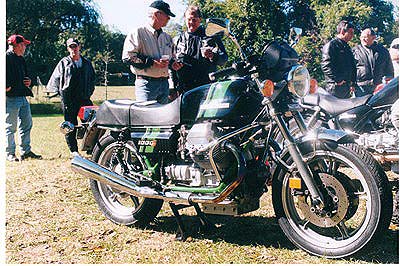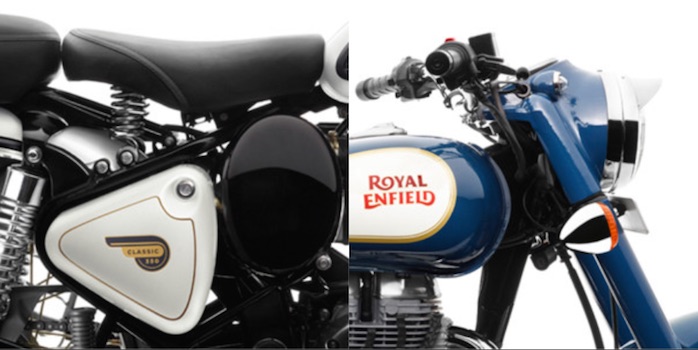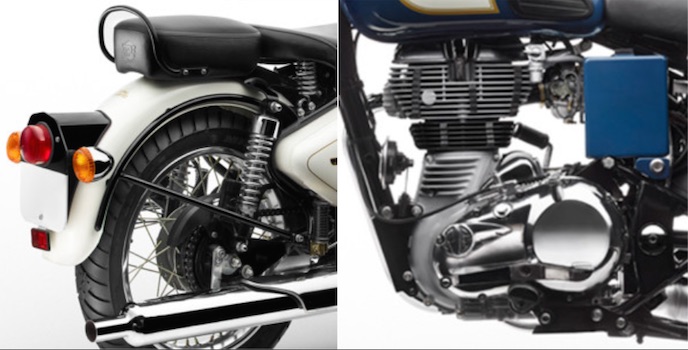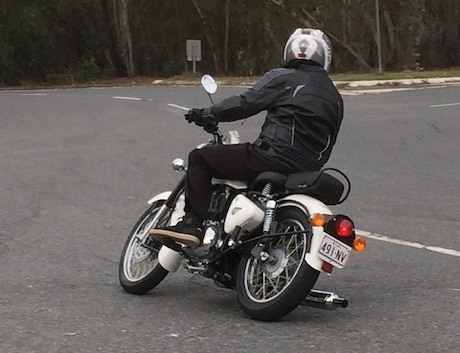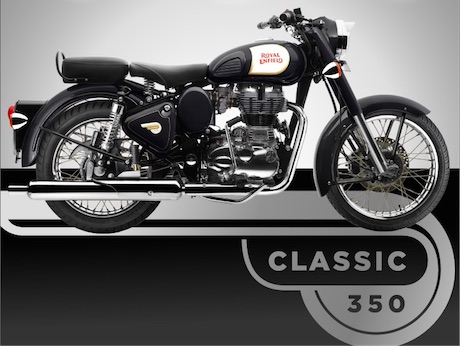The retro-styled Royal Enfield Classic 350 may be a small version of the Classic 500, but it’s no puny weakling. It’s no “bullet” either.
The Classic 350 is carburettor-fed instead of fuel injected and has a smaller bore, but it doesn’t give too much away on the 500, especially in the traffic light derby.
And at just $6490 ride away for the dual-seat Classic 350 compared with $8790 ($8990 chrome edition) for the solo-seat 500, it’s a significant saving.
The Classic 350 is also now available in Chestnut and Mint colours. (They come with dual seats, not solo as pictured below.)
A mate on a Classic 500 accompanied me as I picked up the 350 from Motosport Bayside in Capalaba for our test.
We didn’t get more than 500m before the misty-eyed old guys began gawking.
Stopped at the lights with a truck on either side of us, we were besieged by questions from the drivers drooling out of their respective windows.
It wasn’t the first or last time the retro bike attracted a lot of attention on our test.
The 350 looks identical to the 500. Only four things give it away: the dual seat and dual horns on the 350, the oxygen sensor on the 500’s header pipe and, of course, “350” instead of “500” on the side panels.
Both Classics come with a centrestand as standard and there is a handy grab handle on the side so you can easily lift it on to the stand so you can oil the chain.
And there isn’t much difference when you get on board except the fuel light is replaced by an amp meter, so when it starts to cough, you need to reach down to the left and flick the fuel tap to reserve (and then don’t forget to switch it back to “on” after you have refuelled!)
That’s part of the old-school charm reflected in the timeless styling that includes a kick start as a back-up to the electric start, although I never needed to use it. However, starting a carby bike requires some choke when it’s cold. The knob is a bit difficult to access unless you have long skinny fingers as it’s tucked away behind the fuel tap.
Like the 500, build quality is pretty good; the welds, chrome and paint seem reasonable quality; and all the side covers and fenders are made of metal.
They also both feature a rear wheel that comes off leaving the sprocket and chain in place for roadside puncture repairs!
They’ve also considered you might be doing your own mechanical work while out on the road as they do in India, so they have included a comprehensive and compact tool kit in the lockable left side cover.
However, I wasn’t expecting the 350 to perform near as well as the 500.
The 350 is only down 5.5kW in power, but when total power is only 14.8kW (down from 20.3kW), that’s down by about a quarter. Torque is also down by about the same proportion from 41.3Nm to 28Nm.
Yet, despite the bike weighing only 3kg less, it feels comparable in performance to the 500.
Off the line, it sprints away to 60km/h in less than six seconds thanks to the well-tuned Keihin carby and twin-spark engine. At the top end, it will reach 110km/h on the flat with a slight tail wind and my 80kg aboard.
You wouldn’t want to ride extensive distances on the highway, though, because the buzz through the bars will give you numb fingers within half an hour.
The single-cylinder vibration also makes the high big-eyed mirrors useless.
A pair of aftermarket bar-end mirrors with extra weight should solve the problems of bar vibration and mirror blur.
The Classic 350 is very narrow, so you can easily and legally filter to the front of the traffic (unless you’re a learner or P plater) and you won’t have to worry about holding up the traffic when the lights turn green.
Mind you, the rider has to pin the throttle to the stops and work the smooth one-down, four-up gears to get it to liven up.
Its only limitations are on steep hills where it feels asthmatic.
Despite pinning the throttle a fair bit, the bike scores almost identical fuel economy to the bigger bike, sipping fuel at about 3.5-4L/100km. That should give about 400km in range from the 13.5L tank.
Riding position is a neutral sit-up-and-beg style with a comfortable reach to the bars and pegs.
However, the fat and flat seat feels as hard as Indian marble and within half an hour, it’s quite uncomfortable.
It’s also a quite high and wide seat, so it wouldn’t suit short riders. However, there is plenty of scope for a saddler or upholsterer to lower and soften the sprung tractor-type saddle.
Handling is exactly the same as the 500; under-sprung and over-damped. That makes it a rather bouncy ride, yet it copes well with rough roads and gravel if you keep your speed down.
The combination of the 19inch front and 18inch rear makes it stable at highway speeds, but a little slow at turn-in, however the light weight means you can change direction without a lot of counter-steering bar input.
Brakes are soft and vague with a fair bit of fork dive and the rear drum is almost non-existent, so you have to plan your stops accordingly. There is also no ABS, although the brakes are so soft it’s difficult to lock the wheels even under heavy braking in the wet.
I’d love one as a second bike and I’d buy the 350, rather than the 500, putting the money toward a few modifications such as a customised seat, bar-end mirrors and perhaps a breathing kit. I’d probably still have a couple of thousand dollars left over!
Royal Enfield Classic 350
- Price: $6490 ride away
- Warranty: two-year, unlimited kilometre (parts) and 10,000km and one-year warranty (labour)
- Service: 500/3000km
- Engine: 346cc single-cylinder, Thunderbird Twinspark
- Bore x stroke: 70mm x 90mm
- Compression : 8.5 : 1
- Power: 14.8kW @ 5250rpm
- Torque: 28Nm @ 4000rpm
- transmission: 5-speed, wet multi-plate clutch, chain drive
- Suspension: Telescopic 35mm forks (130mm travel), dual gas-charged shocks with 5-step adjustable preload (80mm travel)
- Wheelbase: 1370mm
- Clearance: 135mm
- Length: 2180 mm
- Width: 790 mm
- Height: 1080 mm
- Kerb weight: 187Kg (with 90% fuel and oil)
- Fuel: 13.5 litre tank
- Tyres: 90/90, 19; 110/90, 18
- Brakes: 280mm single disc, 2-piston calliper; 153mm rear drum
- Colours: white, blue or black



